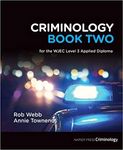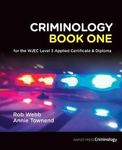Introduction to Criminology at South Devon College
←
→
Page content transcription
If your browser does not render page correctly, please read the page content below
Introduction to Criminology at South Devon College
QUALIFICATION Applied Certificate/Diploma in Criminology
Teacher Name(s) Amber Willis & Fiona Campbell
amberwillis@southdevon.ac.uk
Contact email(s)
fionacampbell@southdevon.ac.uk
Exam board and link WJEC wjec.co.uk
601/6249/1 Applied Certificate
Specification details
601/6248/X Applied Diploma
https://revisesociology.com/tag/criminology/
Recommended online learning https://criminology.uk.net/
https://www.wjec.co.uk/media/21xjkr24/wjec-applied-diploma-
in-criminology-spec-e-03-06-2020.pdf
by Rob Webb
published by Napier Press
Year 1
Textbooks that are used (please
purchase book one prior to
September).
by Rob Webb
published by Napier Press
Year 2
Please complete the activities in this booklet in readiness to begin your studies when you start in
September. This will prepare you for year 1 study and hopefully give you a taster of what you will be
studying in Criminology.Please feel free to contact us if you have any concerns or queries about the work/course
Good Luck and Stay Safe!
Welcome to Applied Criminology!
You have chosen a subject that combines elements of psychology, law and
sociology and that complements studies in humanities. Each unit has an
applied purpose which demands that learning is related to authentic case
studies – this is the interesting bit! It will certainly ‘keep you on your toes’ and
make you think in ways you couldn’t imagine. You will certainly have a very
different outlook on society by the end of your course.
Overview of the course:
This is a two-year course. Units 1 and 2 completed in the first year comprise an
8-hour Controlled Assessment plus a formal externally set examination. This is
replicated in Year 2 with Units 3 and 4. You must complete and pass ALL units
to gain the Diploma. The overall grades will be recorded on a scale A*-E.
Unit 1: Changing Awareness of Crime (Controlled Assessment)
Unit 2: Criminological Theories (Exam)
Unit 3: Crime Scene to Courtroom (Controlled Assessment)
Unit 4: Crime and Punishment (Exam)
Look at the specification for more detail about these topics. You can find this
at: https://www.wjec.co.uk/media/21xjkr24/applied-diploma-in-criminology-
specification-from-2015.pdf
You will be expected to know and understand the information covered, to be
able to apply that knowledge and understanding and to be able to analyse
and evaluate that knowledge and understanding.
Task 1Read the specification carefully and make a note below of the sections there
are to each Unit:
Changing Awareness of Crime…………………………………………………………..
.………………………………………………………………………………….………………
………………………………………………………………….............................................
Criminological Theories…………………………..………………………………………...
…………………………………………………………………………………………………..
…………………………………………………………………...……………………………..
Crime Scene to Courtroom………………………………………………………………..
…………………………………………………………………………………………………..
…………………………………………………………………………………………………..
Crime and Punishment in Society………………………………………………………..
………………………………………………………………………………………………….
…………………………………………………………………..………………………………
Expectations of the course:
• Lessons consist of taking notes, group discussions, watching relevant
DVDs/documentaries, group work and PowerPoint presentations.
• Homework consists of note making, wider reading, research, past exam
questions, power points and essays.
• The Reading and Watching List on the following page will help you to
gain wider knowledge and a broader framework in which to apply
your knowledge. You will be expected to choose something to
watch/read every half term and to feed back to the rest of the class.
You may do this individually, in pairs or groups.
• You are expected to use the resources available to you in the library
and the textbook for each year of study.
• Your folders of notes will be checked on a regular basis to see if you are
organised and up to date with your work.
• USE YOUR STUDY TIME AND BE PRO-ACTIVE.• Reading List - Criminology
• Folk Devils and Moral Panics – Stanley Cohen
• A Glasgow Gang Observed – Patrick James
• Gang Leader For A Day – Sudhir Venkatesh
• Fake Law – The Secret Barrister
• Traces: Memoir of a Forensic Scientist and Criminal
Investigator – Patricia Wiltshire
• My Life With Murderers – David Wilson
• A wide range of newspapers including The Guardian and
Independent
Watching List - Criminology
• Any documentaries, including Panorama, Louis Theroux,
Stacey Dooley, Mind of a Murderer etc
• Black Mirror series (Netflix)
• Goodfellas
• The Godfather (part 2 is the best)
• Legend
• McMafia (previously BBC i-player)
• Freedom Writer’s Diary
• Dangerous Minds
• Chernobyl (drama)
• When They See Us (Netflix)
• The Society (Netflix)
• Blood Diamond
• Ted Talks/Crime/Criminal Justice
• Orange is the New Black (Netflix)
• The Innocence Files (Netflix)
• Cold Case Files (Netflix)
• I Am A Killer (Netflix)
• When They See Us Now – Oprah Winfrey (Netflix)
• The Stanford Prison Experiment (Youtube)
• The Push – Derren Brown (Netflix)
• MacIntyre Undercover: The Chelsea Headhunters (Youtube)
• The Shawshank Redemption
• The Green Mile
• Bad Boys IITask 2- Criminal Factfile
• Below are a list of victims and offenders for you to research:
Figure 2 Bernie Maddoff Figure 1 Gary Dobson & David Norris
Figure 4 Shafilea Ahmed
Figure 3 Jimmy Carr
Figure 5Robert Thompson and Jon Venables
Figure 6 Billy Dunlop
• Write a fact file for each (**Make sure you keep these for Year 1 they will
be very useful!**) which should include the following information:
1. Their crimes or crime that has been committed against them and victims
2. Details of the crime committed – what type of crime was committed tax
fraud or murder etc.3. Details of their sentence if there was any 4. Information about their background which might explain their criminal behaviour such as head injuries, mental illness, childhood abuse Task 3 Watch the following clip and jot down 5 things that tell you what Criminology is. https://www.youtube.com/watch?v=tdaqqlFQdTE Task 4 What’s the difference between crime and deviance? A crime can be defined as ………………………………………………………………. ………………………………………………………………………………………………….. Deviance is ………………………………………………………………………………….. …………………………………………………………………………………………………..
Examples of crimes are: …………………………………………………………………... ………………………………………………………………………………………………….. Examples of deviance are: ………………………………………………………………. ………………………………………………………………………………………………….. Task 5 Think of 3 different ways society has changed over the last 100 years. Try to be specific about the change eg. homosexuality is no longer illegal. 1. …………………………………………………………………………………………….. 2. …………………………………………………………………………………………….. 3. …………………………………………………………………………………………….. Now, name 3 ways in which British society is different to another (America, Italy etc.) 1. …………………………………………………………………………………………… ………………………………………………………………………… 2. …………………………………………………………………….. …………………………………………………………………………… 3. …………………………………………………………………………………………… ………………………………………………………………………………………………… Task 6
Research the following types of crime. You need to understand the definition
of the type of crime, the typical offender and the typical victim.
1. State Crime
Definition……………………………...............................................................................
.......................................................................................................................................
Typical Offender …………………………………………………………………………….
Typical Victim …………………………………………………………………………......
Example: ……………………………………………………………………………………
…………………………………………………………………………………………………
…………………………………………………………………………………………………
…………………………………………………………………………………………………
…………………………………………………………………………………………………
2. White Collar Crime
Definition……………………………...............................................................................
.......................................................................................................................................
Typical Offender …………………………………………………………………………….
Typical Victim ………………………………………………………………………….........
Example: ……………………………………………………………………………………...
…………………………………………………………………………………………………
…………………………………………………………………………………………………
…………………………………………………………………………………………………
…………………………………………………………………………………………………
3. Moral Crimes
Definition……………………………......................................................................................................................................................................................................................
Typical Offender …………………………………………………………………………….
Typical Victim ………………………………………………………………………….........
Example: ……………………………………………………………………………………...
…………………………………………………………………………………………………..
…………………………………………………………………………………………………..
…………………………………………………………………………………………………
…………………………………………………………………………………………………
4. Technological Crimes
Definition……………………………...............................................................................
.......................................................................................................................................
Typical Offender …………………………………………………………………………….
Typical Victim ………………………………………………………………………………
Example: ……………………………………………………………………………………...
…………………………………………………………………………………………………
…………………………………………………………………………………………………
…………………………………………………………………………………………………
…………………………………………………………………………………………………
5. Hate Crime
Definition……………………………...............................................................................
.......................................................................................................................................
Typical Offender …………………………………………………………………………….Typical Victim …………………………………………………………………………...... Example: ……………………………………………………………………………………... ………………………………………………………………………………………………….. ………………………………………………………………………………………………… ………………………………………………………………………………………………… ………………………………………………………………………………………………… Task 7 As part of your course you will have to look at campaigns that have caused a change in the law. You will also have to plan your own campaign. Conduct research on the following campaigns. Find out what the original crime was that sparked the campaign; what the aim of the campaign was; what methods were used (eg. TV interviews, advertising, wristbands, petitions, T-shirts etc) and whether the campaign was successful. Sarah’s Law The Double Jeopardy Law Dignity in Dying Snowdrop Campaign Slow Down for Bobby Anti-Foxhunting Campaign Task 8 Research how newspapers report crime and the types of crime they report on. Consider differences between local newspapers, national newspapers, tabloids and broadsheets in their reporting of crime. Newspaper 1 Name: …………………………………………………………………………………………
Types of crime reported: …………………………………………………………………. ………………………………………………………………………………………………..... ………………………………………………………………………………………………….. ………………………………………………………………………………………………….. Examples of headlines/language used: ………………………………………………. ………………………………………………………………………………………………….. ………………………………………………………………………………………………….. ………………………………………………………………………………………………….. Newspaper 2 Name: ………………………………………………………………………………………… Types of crime reported: …………………………………………………………………. ………………………………………………………………………………………………..... ………………………………………………………………………………………………….. ………………………………………………………………………………………………….. Examples of headlines/language used: ………………………………………………. ………………………………………………………………………………………………….. ………………………………………………………………………………………………….. ………………………………………………………………………………………………….. Newspaper 3 Name: ………………………………………………………………………………………… Types of crime reported: …………………………………………………………………. ………………………………………………………………………………………………..... ………………………………………………………………………………………………….. ………………………………………………………………………………………………….. Examples of headlines/language used: ………………………………………………. ………………………………………………………………………………………………….. ………………………………………………………………………………………………….. ………………………………………………………………………………………………….. Newspaper 4
Name: ………………………………………………………………………………………… Types of crime reported: …………………………………………………………………. ………………………………………………………………………………………………..... ………………………………………………………………………………………………….. ………………………………………………………………………………………………….. Examples of headlines/language used: ………………………………………………. ………………………………………………………………………………………………….. ………………………………………………………………………………………………….. …………………………………………………………………………………………………..
You can also read

























































